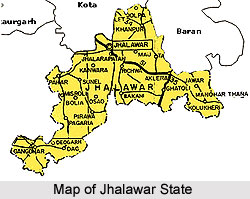 The Princely State of Jhalawar was one of the major states during the rule of the British Empire in India. The erstwhile ruling family of Jhalawar state belonged to the Jhala dynasty of Rajputs, and the ancestors these Indian princes were rulers of Halwad in Jhalawar District, in Kathiawar. Around 1709, one of the sons of the Chief of the dynasty went away from their country with his son in order to avail better opportunities in Delhi. He left his son Madhu Singh at Kota, who eventually gained respect of the Maharaja. The King bestowed him with an essential designation, which became hereditary. After the death of one of the rulers of Kota in 1771, the territory was left under the administration of Zalim Singh, who was a descendant of Madhu Singh. Since then, Zalim Singh ascended the royal throne and became the king of Kota. During his reign, the territory came under a magnificent state of prosperity, which lasted for around 45 years and the region of Kota became a reputed and respected territory.
The Princely State of Jhalawar was one of the major states during the rule of the British Empire in India. The erstwhile ruling family of Jhalawar state belonged to the Jhala dynasty of Rajputs, and the ancestors these Indian princes were rulers of Halwad in Jhalawar District, in Kathiawar. Around 1709, one of the sons of the Chief of the dynasty went away from their country with his son in order to avail better opportunities in Delhi. He left his son Madhu Singh at Kota, who eventually gained respect of the Maharaja. The King bestowed him with an essential designation, which became hereditary. After the death of one of the rulers of Kota in 1771, the territory was left under the administration of Zalim Singh, who was a descendant of Madhu Singh. Since then, Zalim Singh ascended the royal throne and became the king of Kota. During his reign, the territory came under a magnificent state of prosperity, which lasted for around 45 years and the region of Kota became a reputed and respected territory.
In the year 1838, with the approval of the ruler of Kota, it was decided to dismember the state and to form the new principality of Jhalawar, which was created as a distinct provision for the descendants of Zalim Singh. The detached districts from Kota were considered to stand for one third of the income of the region. They acknowledged the suzerainty of the British East India Company through treaty and decided to pay an annual tribute of lump sum amount. The title of Maharaja Rana was bestowed to Madan Singh, who was placed on an equal traction as the other chiefs in Rajputana. Maharaja Rana Madan Singh died in the year 1845.
In 1875, the adopted son of his successor took the name of Zalim Singh and ascended the throne and became the ruler of Jhalawar. As he was still a minor at the time, he ruled under a regent and was not invested with full ruling powers until he reached the age of majority in 1884. Due to maladministration various mismanagement issues, his association with the British administration became stressed. Later in the year 1896, the ruler was deposed by the British Government of India due to constant misgovernment and proved unfit for the powers of a ruling leader. The administration of the territory was placed under a political agent or resident of British India. The former ruler settled in Varanasi. Even at the present age the Jhala dynasty of Rajputs are considered as the head of the state and therefore maintain a large majority of their power over Jhalawar.
In the year 1897, the British administration decided, after much consideration, to divide the state and restored the greater part to Kota. It also formed the 2 districts of Chaumahla and Shahabad into a new state that covered a total area of 2,100 sq km. these territories came into existence in 1899. A descendant of the original Zalim Singh, Kunwar Bhawani Singh, was appointed as the chief. In the year 1901, the total population of the state was 90,175.
Successors for Maharana of the Princely State of Jhalawar
Sh. Madan Singh, Maharaja Rana of Jhalawar from 1838 to 1845)
Sh. Pirthi Singh, Maharaja Rana of Jhalawar from 1845 to 1875)
Sh. Bakht or Zalim Singh, Maharaja Rana of Jhalawar from 1875 to 1897)
His Highness Sh. Bhawani Singh, Maharaja Rana of Jhalawar from 1897 to 1929
His Highness Sh. Rajendra Singh, Maharaja Rana of Jhalawar from 1929 to 1943)
His Highness Sh. Harish Chandra, Maharaja Rana of Jhalawar from 1943 till the merger of Jhalawar State with Rajasthan.



















